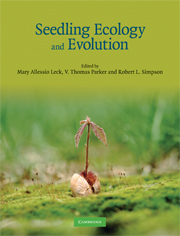Book contents
- Frontmatter
- Contents
- Contributors
- Foreword by Peter J. Grubb
- Preface
- Acknowledgments
- Part I Introduction
- Part II Seedling diversity
- Chapter 2 Seedling natural history
- Chapter 3 Specialized seedling strategies I: seedlings in stressful environments
- Chapter 4 Specialized seedling strategies II: orchids, bromeliads, carnivorous plants, and parasites
- Part III Seedling morphology, evolution, and physiology
- Part IV Life history implications
- Part V Applications
- Part VI Synthesis
- References
- Index
Chapter 4 - Specialized seedling strategies II: orchids, bromeliads, carnivorous plants, and parasites
Published online by Cambridge University Press: 05 June 2012
- Frontmatter
- Contents
- Contributors
- Foreword by Peter J. Grubb
- Preface
- Acknowledgments
- Part I Introduction
- Part II Seedling diversity
- Chapter 2 Seedling natural history
- Chapter 3 Specialized seedling strategies I: seedlings in stressful environments
- Chapter 4 Specialized seedling strategies II: orchids, bromeliads, carnivorous plants, and parasites
- Part III Seedling morphology, evolution, and physiology
- Part IV Life history implications
- Part V Applications
- Part VI Synthesis
- References
- Index
Summary
Introduction
This chapter focuses on phylogenetically diverse groups of plants that do not have typical life history strategies as seedlings, juveniles, and mature individuals. Plants that live on other plants are classified as epiphytes, and they include both vascular and nonvascular species (Benzing, 1990). Tropical orchids and bromeliads comprise the vast majority of epiphytic flowering plants. However, orchids are global in their distribution and many are terrestrial (Dixon et al., 2003). Carnivorous plants are also globally distributed, occurring in many types of ecosystems (Lloyd, 1976), as are parasitic plants (Press & Graves, 1995). The ability of seedlings to establish in habitats with extreme limiting resources is one of the few factors that links the diverse plants covered in this chapter. Epiphytes, for example, must initially become established on structures (i.e. branches) where resources are scarce. Once established, epiphytes may have to deal with combinations of stresses, including aridity, few available nutrients, and either high or low light conditions. Carnivorous plant species and many terrestrial orchids occur in habitats where nutrients or light are limiting. Many parasitic plants (e.g. mistletoes) also occur in resource-limited environments.
One of our approaches to organizing this chapter is to determine if seedlings differ in their physical or ecological characteristics in a manner similar to mature plants. The literature has few examples of investigations focusing specifically on seedlings. As an example, in the seminal book on Bromeliaceae, Benzing (2000) did not consider seedlings as a separate heading.
- Type
- Chapter
- Information
- Seedling Ecology and Evolution , pp. 79 - 100Publisher: Cambridge University PressPrint publication year: 2008
- 7
- Cited by



